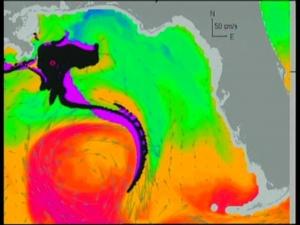-
 Oil platform in the Gulf of Mexico on fire
Oil platform in the Gulf of Mexico on fire
Some of you may have read about this elsewhere. It's a big topic now for anyone who's a fish or outdoors person. It may end up being one of the biggest ecological disasters this decade.
It will definitely affect the fishing in the Gulf for quite some time.
Anyone who has any more info or comments, feel free to post up.
-

They said you could see the flames 35 miles away, that must have been some fire.
-

http://news.yahoo.com/s/ap/20100516/...gulf_oil_spill
BP: Mile-long tube sucking oil away from Gulf well
By JEFFREY COLLINS and JASON DEAREN, Associated Press Writers Jeffrey Collins And Jason Dearen, Associated Press Writers – 31 mins ago
HAMMOND, La. – In a major step toward containing a massive Gulf of Mexico oil leak, BP said a mile-long tube was funneling crude Sunday from a blown well to a tanker ship after three days of wrestling to get the stopgap measure into place on the seafloor.
The contraption was hooked up successfully and sucking oil from a pipe at the blown well Sunday afternoon after being hindered by several setbacks. Engineers remotely guiding robot submersibles had worked since Friday to place the tube into a 21-inch pipe nearly a mile below the sea.
Kent Wells, BP's senior vice president for exploration and production, said during a news conference that the amount being drawn was gradually increasing, and it would take several days to measure it. Company spokesman Mark Proegler at the joint spill command center in Louisiana had initially said the tube was containing most of the oil coming from the pipe, which is contributing an estimated 85 percent of the crude in the spill.
Previous attempts to use emergency valves and a 100-ton container had failed to stop the leak that has spilled millions of gallons of oil into the Gulf, threatening sea life, commercial fishing and the coastal tourist industry from Louisiana to Florida. BP PLC has also been burning small amounts of floating oil and spraying chemical dispersants above and below the surface.
The tube's success gave crews partial control of the leak for the first time in more than three weeks. Oil has been spewing since the rig Deepwater Horizon exploded April 20, killing 11 people and sinking two days later. The government shortly afterward estimated the spill at 210,000 gallons — or 5,000 barrels — a day, a figure that has since been questioned by some scientists who fear it could be far more. BP executives have stood by the estimate while acknowledging there's no way to know for sure.
Researchers warned Sunday that miles-long underwater plumes of oil from the spill could poison and suffocate sea life across the food chain, with damage that could endure for a decade or more.
Researchers have found more underwater plumes of oil than they can count from the blown-out well, said Samantha Joye, a professor of marine sciences at the University of Georgia. She said careful measurements taken of one plume showed it stretching for 10 miles, with a 3-mile width.
The hazardous effects of the plume are twofold. Joye said the oil itself can prove toxic to fish swimming in the sea, while vast amount of oxygen are also being sucked from the water by microbes that eat oil. Dispersants used to fight the oil are also food for the microbes, speeding up the oxygen depletion.
"So, first you have oily water that may be toxic to certain organisms and also the oxygen issue, so there are two problems here," said Joye, who's working with a group of scientists who discovered the underwater plumes in a recent boat expedition to the Gulf. "This can interrupt the food chain at the lowest level, and will trickle up and certainly impact organisms higher. Whales, dolphins and tuna all depend on lower depths to survive."
She said it could take years or even decades for the ecosystem to recover.
Oil has been spewing since the rig Deepwater Horizon exploded April 20, killing 11 people and sinking two days later.
BP has been casting about for ways to contain the leak since it was discovered several days after the blast. First robot submarines were unable to get valves to work on machinery at the well head called the blowout preventer. Then the company failed to capture the oil with a 100-ton box after icelike crystals formed in it.
A relief well, considered the permanent solution the leak, is still being drilled and is months away from completion.
-

Billions in economic losses.
-

That we will be making up.
-

Just heard on the news that it was natural gas they were burning off.
-

An update
At worst, oil spewed already could fill 102 gyms
 AP – A May 17, 2010 satellite image provided by NASA shows a large patch of oil visible near the site of the …
AP – A May 17, 2010 satellite image provided by NASA shows a large patch of oil visible near the site of the …
By SETH BORENSTEIN and GREG BLUESTEIN, Associated Press Writers Seth Borenstein And Greg Bluestein, Associated Press Writers – Fri May 21, 6:12 am ET
COVINGTON, La. – Drip by drip, day by day, the oil gushing into the Gulf of Mexico is adding up to mind-boggling numbers.
Using worst case scenarios calculated by scientists, a month's worth of leaking oil could fill enough gallon milk jugs to stretch more than 11,300 miles. That's more than the distance from Buenos Argentina, and back. That's just shy of 130 million gallons.
If the government's best case scenario is used — and only 5.25 million gallons have spilled — those milk jugs would cover a bit more than a roundtrip between New York and Washington. But the government is revising that number, with a team of scientists working around the clock to come up with a more realistic and likely higher figure.
Here's another way to think of just how much oil has gushed out since April 20: At worst, it's enough to fill 102 school gymnasiums to the ceiling with oil.
That's nothing compared to the vast expanse of the Gulf of Mexico, where there are 643 quadrillion gallons. Even under the worst case scenario, the Gulf has five billion drops of water for every drop of oil. And the mighty Mississippi River pours 3.3 million gallons of new water into Gulf every second.
Under the rosiest scenario, little more than four gyms would be filled. That's how the National Oceanic and Atmospheric Administration visualizes oil spill volumes on one of its websites.
At worst, the amount of oil that has already spilled is a dozen times more than the.
At best, it's only half as bad. Realistically, it's probably somewhere in that huge middle in between.
No matter what, it already is way too much oil for the delicate parts of the Gulf ecosystem, said Darryl Felder, a biologist at the University of Louisiana Lafayette.
"A lot of this is diffused now in deep layers," said Felder, who is coordinating a seven-volume scientific encyclopedia on the Gulf. "It's like it's under the rug. You can't see it on the surface, so it's kind of out of sight, out of mind. But it's not out of mind to most of the biologists who are concerned about its long-term effects."
There are many uncertainties about how much has spilled. It's not even clear if the leak began on April 20, when the rig exploded, or April 22 when the rig sank, or on April 24 when they first noticed two leaks.
Originally, BP and the federal government said 42,000 gallons were flowing per day. Then the number was upped to 210,000 and that's been the best case scenario, with calculations that the spill didn't start until April 24.
The best case scenario seems increasingly unlikely. On Thursday, BP acknowledged more oil than that is pouring into the Gulf. The company said its makeshift tube put in place to suck up the leak is siphoning 210,000 gallons a day into a barge — the full amount of oil the company said was leaking. Yet, there's still lots of oil flowing out into the Gulf that can now be seen live on a webcam.
"Anyone can look at that and determine that even though it can't be metered or measured, it's significantly less than it was," said company spokesman Steve Rinehart. "That suggests pretty clearly that taking 5,000 barrels a day (210,000 gallons) out of that stream puts a real dent in it."
Federal officials acknowledge their 210,000 gallons-a-day figure needs to be revised. NOAA director Jane Lubchenko said the old estimate was based on a long-held international scientific formula based on surface slick observations. But the way this oil slick changed makes that calculation no longer useful, she said.
The worst case scenario is based on the upper end of broad estimates from several scientists for the daily flow rate of the leak based on video observation — somewhere between 840,000 gallons a day and 4.2 million gallons a day.
Some experts say the 4.2 million gallon rate is probably way too high, just like the government figures are way too low. That's because somewhere around 1.2 million to 1.6 million gallons a day is all that can realistically be expected from that type of well if it were working right, they said.
Ian McDonald, a Florida State University oceanographer and expert tracking the spill, said both estimates were wrong, but the government figure is especially wrong.
"We don't know how bad this is," McDonald said Thursday. "One of the problems is it's going to be very hard to know." McDonald said the spill's surface slick is now more than 14,600 square miles, larger than the states of Maryland and Delaware combined.
 Posting Permissions
Posting Permissions
- You may not post new threads
- You may not post replies
- You may not post attachments
- You may not edit your posts
-
Forum Rules




 Reply With Quote
Reply With Quote Play Video
Play Video 

 Play Video
Play Video  Play Video
Play Video 